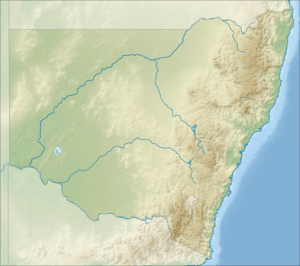Rocky Ponds Creek
| Rocky Ponds | |
| Spring[1] | |
| Creek | |
| Country | Australia |
|---|---|
| State | New South Wales |
| Regions | South Eastern Highlands (IBRA), South West Slopes |
| Local government area | Harden |
| Part of | Murrumbidgee catchment, Murray–Darling basin |
| Source | Great Dividing Range |
| - location | east of Murrumburrah |
| - elevation | 404 m (1,325 ft) |
| - coordinates | 34°31′56″S 148°31′5″E / 34.53222°S 148.51806°E |
| Mouth | confluence with the Jugiong Creek |
| - location | west of Binalong |
| - elevation | 315 m (1,033 ft) |
| - coordinates | 34°41′33″S 148°28′56″E / 34.69250°S 148.48222°ECoordinates: 34°41′33″S 148°28′56″E / 34.69250°S 148.48222°E |
| Length | 25 km (16 mi) |
 | |
| [2] | |
The Rocky Ponds Creek, a watercourse[1] that is part of the Murrumbidgee catchment within the Murray–Darling basin, is located in the South West Slopes region of New South Wales, Australia.
Course and features
The Rocky Ponds Creek (technically a river[1]) rises below Rocky Ponds, approximately 16 kilometres (9.9 mi) east of the town of Murrumburrah, on the south western slopes of the Great Dividing Range. The creek flows generally west and then south before reaching its confluence with the Jugiong Creek (itself a tributary of the Murrumbidgee River) near the locality of Hidden Brook, and west of Binalong. The creek descends 89 metres (292 ft) over its 25-kilometre (16 mi) course.[2]
The Burley Griffin Way crosses the creek in the parish of Cumbamurra.
See also
References
- 1 2 3 "Rocky Ponds Creek". Geographical Names Register (GNR) of NSW. Geographical Names Board of New South Wales. Retrieved 5 January 2015.
- 1 2 "Map of Spring Creek, NSW". Bonzle Digital Atlas of Australia. Retrieved 5 January 2015.
External links
- Trueman, Will (2012). True Tales of the Trout Cod: River Histories of the Murray–Darling Basin (Lachlan River catchment booklet) (PDF). Canberra: Murray–Darling Basin Authority. ISBN 978-1-921914-98-0.
- Murrumbidgee Catchment Management Authority website
- "Murrumbidgee and Lake George catchments" (map). Office of Environment and Heritage. Government of New South Wales.
This article is issued from Wikipedia - version of the 1/5/2015. The text is available under the Creative Commons Attribution/Share Alike but additional terms may apply for the media files.